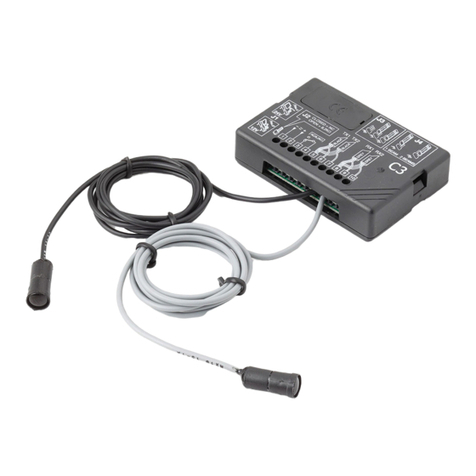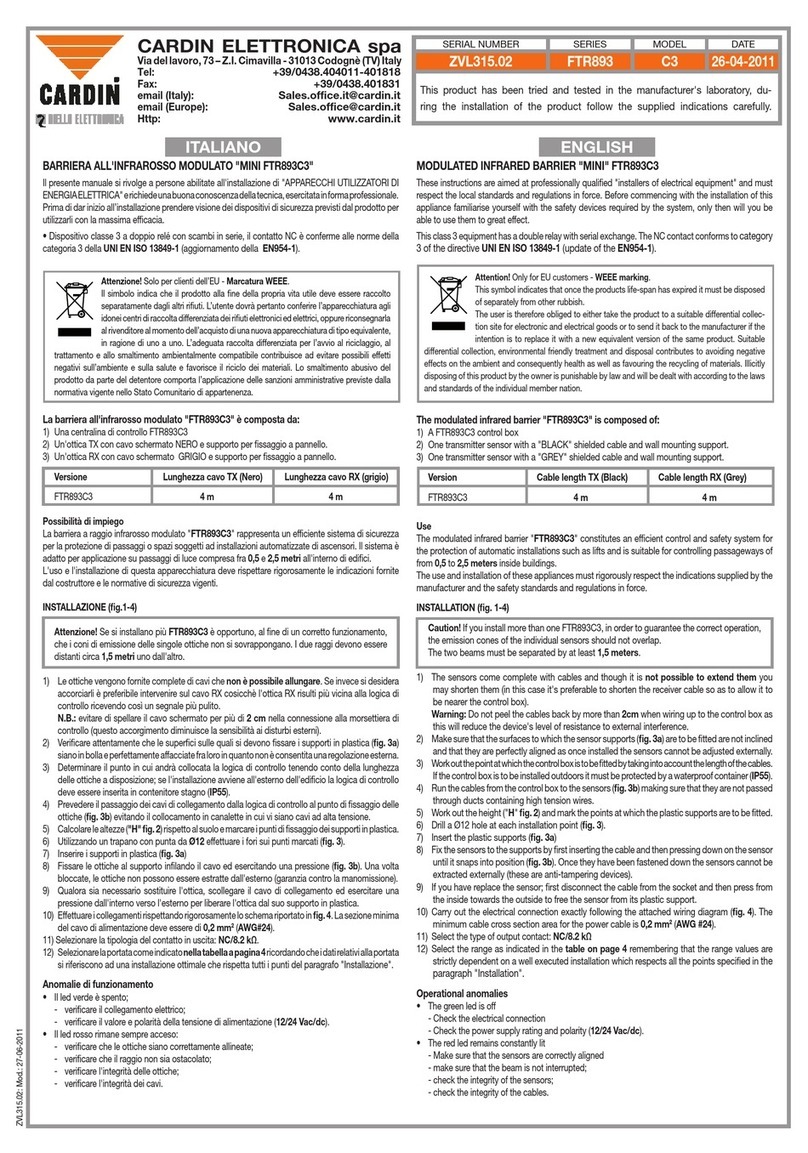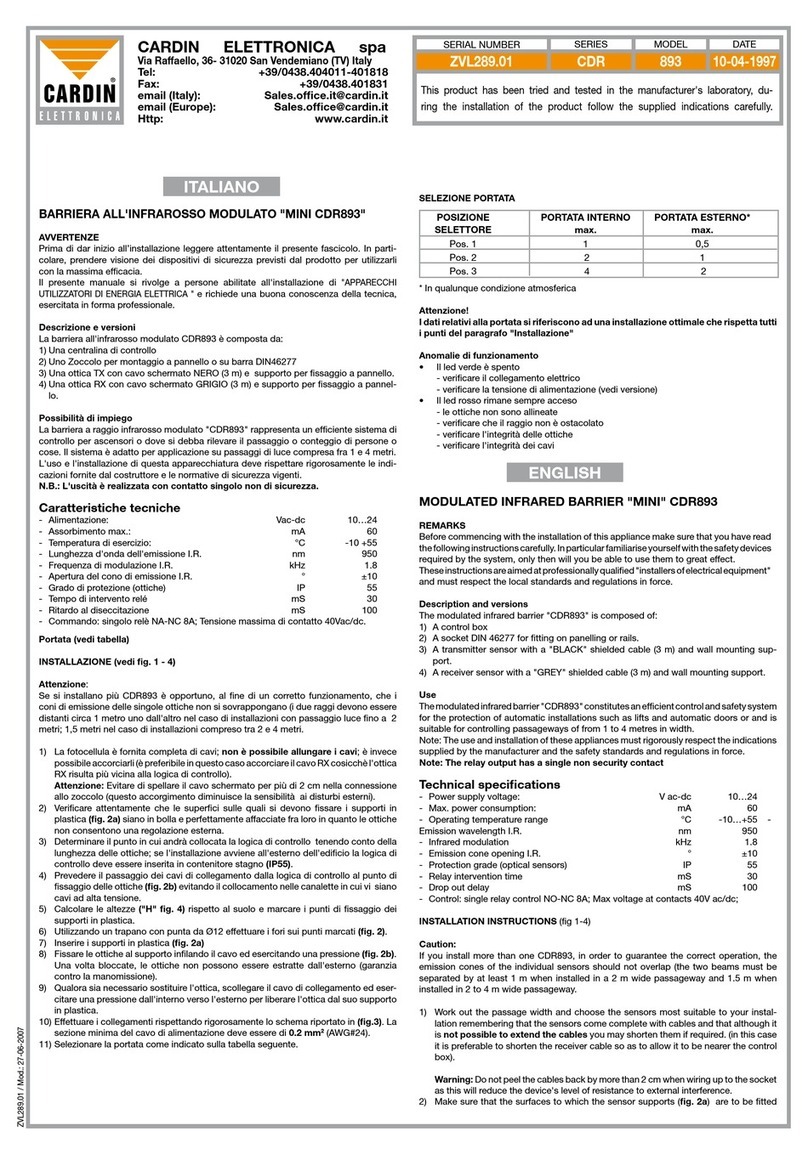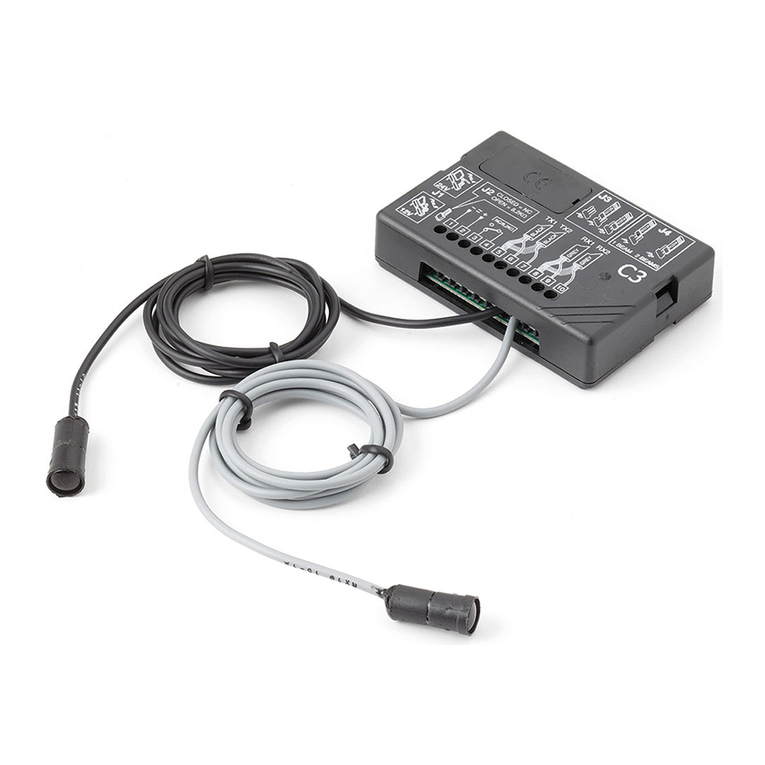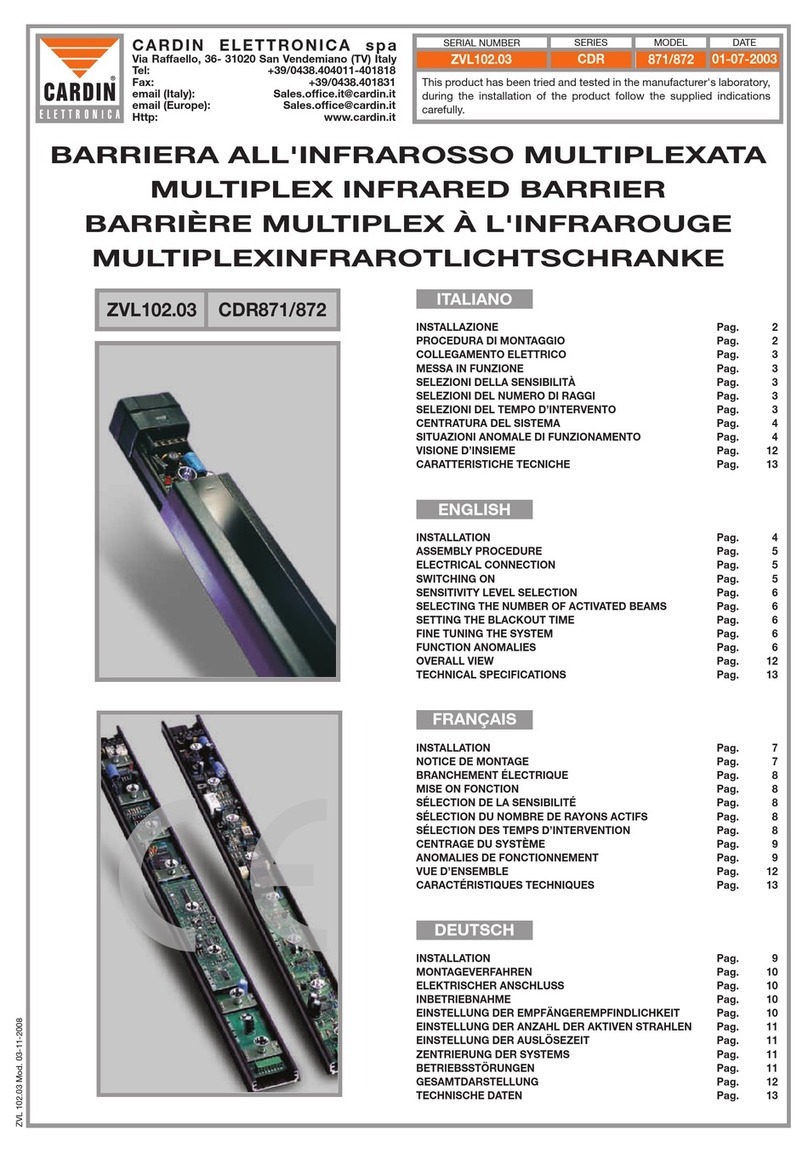
BARRIERE A INFRAROUGE MODULE "MINI CDR891"
REMARQUE
Ce livret est destiné à des personnes titulaires d’un certificat d’aptitude professionnelle pour
l’installation des "APPAREILS ÉLECTRIQUES" et requiert une bonne connaissance de la
technique appliquée professionnellement.
Avant de procéder à l’installation, lire attentivement ce livret. En particulier, se familiariser avec
les dispositifs de sécurité prévus sur le produit afin de pouvoir les utiliser au mieux.
Description et versions
La barrière à l’infrarouge modulé "CDR891" est constituée de:
1) la centrale de contrôle CDR891;
2) une embase pour montage sur panneau ou sur barre DIN46277;
3) une tête optique TX munies de câble blindé NOIR et de support de fixation sur panneau;
4) une tête optique RX munies de câble blindé GRIS et de support de fixation sur panneau.
La longueur du câble des têtes optiques varie en fonction des versions:
Version Longueur câble TX (Noir)Longueur câble RX (Gris)
CDR891 standard 5 m 3 m
CDR891-1 (en option) 10 m 7 m
CDR891-2 (en option) 15 m 10 m
Applications possibles
La barrière à l’infrarouge modulé "CDR891" est un système de sécurité efficace, conçu pour la
protection de passages ou d’endroits destinés à des installations automatisées d’ascenseurs,
portes ou zones qui nécessitent la détection de passage ou le comptage de personnes et de
matériels. Le système est indiqué pour des passages d’une dimension comprise entre 1 et 8.
Pour l’utilisation et l’installation de cet appareil, se conformer aux indications fournies par le
Constructeur et aux normes de sécurité en vigueur.
INSTALLATION (voir fig.1 - 4)
Attention! En cas d’installation de plusieurs CDR891, il est nécessaire pour obtenir un bon
fonctionnement que les cônes d’émission des têtes optiques ne se chevauchent pas (les
deux faisceaux doivent être distants l’un de l’autre de 1m environ en cas d’installations
avec passage d’une dimension de 2m, de 1,5m en cas d’installations avec passage d’une
dimension 4m et de 2m en cas d’installations avec passage d’une dimension de 8m).
1) Déterminerla dimensiondupassageet choisiren conséquencelestêtesoptiquesindiquées
à l’installation. Les têtes optiques sont fournies munies de câbles; il n’est pas possible de
rallongerlescâbles.Ceux-cipeuventparcontreêtreraccourcis(danscecasilestconseilléde
raccourcirlecâbleRXdefaçonquelatêteoptiqueRXsoitplusprochedelalogiquedecontrôle).
Attention: éviter de dénuder le câble blindé de plus de 2cm dans la connexion de l'embase
(ceci réduit la sensibilité aux parasites).
2) Vérifier soigneusement que les surfaces qui reçoivent les supports en plastique (fig.3a)
soient à niveau et parfaitement alignées l’une par rapport l’autre, considéré que les têtes
optiques ne permettent pas un réglage de l’extérieur.
3) Déterminer l’emplacement de la logique de contrôle en tenant compte de la longueur des
têtes optiques à disposition.
En cas d’installation à l’extérieur de l’édifice, la logique de contrôle doit être logée dans un
boîtier étanche (IP55).
4) Prévoir le passage des câbles de branchement de la logique de contrôle jusqu’au point
de fixation des têtes optiques (fig. 3b). Éviter de les faire passer dans des conduites dans
lesquelles se trouvent des câbles haute tension.
5) Calculer les hauteurs ("H" fig. 2) par rapport au sol et tracer les points de fixation des
supports en plastique.
6) Utiliser une perceuse et un forêt de Ø12 pour pratiquer les trous aux endroits tracés (fig. 3).
7) Fixer les supports en plastique (fig. 3a).
8) Enfiler le câble et fixer les têtes optiques au support en exerçant une certaine pression (fig.
3b). Une fois fixées, les têtes optiques ne peuvent pas être extraites de l’extérieur (sécurité
contre les risques de vandalisme).
9) Encas deremplacement d’unetêteoptique,débrancherle câblede branchementetexercer
une pression de l’intérieur vers l’extérieur pour la dégager de son support en plastique.
10) Effectuer le branchement en observant scrupuleusement le schéma reporté en (fig. 4). La
section minimale du câble d’alimentation doit être de 0,2mm2(AWG#24).
11) Pour la sélection de la portée, se référer au tableau ci-dessous:
SÉLECTION PORTÉE
POSITION PORTÉE INTÉRIEURE PORTÉE EXTÉRIEURE*
SÉLECTEUR maxi. max.
Pos. 1 2 m 1,5 m
Pos. 2 4 m 3 m
Pos. 3 8 m 6 m
* En n’importe quelle condition atmosphérique
Attention! Les données inhérentes à la portée se réfèrent à une installation effectuée
conformément aux instructions du paragraphe "Installation"
Anomalies de fonctionnement
• Le led vert est éteint:
- vérifier le branchement électrique;
- vérifier la tension d’alimentation (12-24Vac/dc)
• Le led rouge reste toujours allumé.
- les têtes optiques ne sont pas bien alignées
- vérifier que le faisceau ne soit pas interrompu;
- vérifier l’intégralité des têtes optiques;
- vérifier l’intégralité des câbles.
DEUTSCH
MODULIERTE INFRAROTLICHTSCHRANKE "MINI CDR891"
HINWEIS
Das vorliegende Handbuch wendet sich an Personen, die zur Installation von "ELEKTROGERÄTEN" befähigt
sind und setzt eine gute berufliche Kenntnis der Technik voraus. Bevor mit der Installation begonnen wird,
sollte das vorliegende Heft aufmerksam gelesen werden. Insbesondere sollten die vom Produkt vorgese-
henen Sicherheitseinrichtungen zwecks bester Effizienz in Augenschein genommen werden.
Beschreibung und Ausführungen
Die modulierte Infrarotlichtschranke "CDR891", besteht aus:
1) der Kontrollzentrale CDR891;
2) Sockel zur montage an der Fläche oder auf einer Stange DIN46277
3) einer Sender Optik komplett mit SCHWARZEM abgeschirmten Kabel und Träger zur Befestigung an
der Fläche.
4) einer Empfänger Optik komplett mit GRAUEM abgeschirmten Kabel und Träger zur Befestigung an der
Fläche.
Die Kabellänge ist je nach Version verschieden:
Ausführung Sender Kabellänge (Schwarz)Empfänger Kabellänge (Grau)
CDR891 standard 5 m 3 m
CDR891-1 (auf Wunsch) 10 m 7 m
CDR891-2 (auf Wunsch) 15 m 10 m
Einsatzmöglichkeiten
Die Infrarotlichtschranke "CDR891" stellt ein wirksames Sicherheitssystem zum Schutz von Durchgängen
oder Flächen, bei denen automatische Installationen von Aufzügen und Türen vorgenommen werden oder
wo der Durchgang von Personen oder Dingen erfasst oder deren Zählung vorgenommen werden muss.
Sie ist geeignet für Durchgänge mit einer Weite zwischen 1 und 8 m. Die Verwendung und die Installation
dieser Geräte muss unter der genauen Befolgung der vom Hersteller gegebenen Anweisungen und der
geltenden Sicherheitsbestimmungen erfolgen.
INSTALLATION (siehe Abb. 1 - 4)
Achtung! Wenn mehrere CDR891 installiert werden, dürfen sich die Strahlungskegel der einzelnen
Optiken nicht überlagern, um eine korrekte Funktionsweise zu gewährleisten. Die beiden Lichtstrahlen
müssen einen Abstand voneinander von zirka 1 m haben im Falle von Installationen mit einer Torweite
von 2 m; 1,5 m im Falle von Installationen mit einer Torweite von 4 m und 2 m Falle von Installationen
mit einer Torweite von 8 m.
1) Bestimmen Sie die Torweite und wählen Sie die zur Installation geeigneten Optiken, wobei Sie sich
daran erinnern sollten, dass die Optiken komplett mit ihren Kabeln geliefert werden; ein Verlängern
der Kabel ist nicht möglich; sie können aber verkürzt werden (in diesem Fall ist die Verkürzung des
Empfängerkabels vorzuziehen, so dass die Optik des Empfängers näher zur Kontrollogik kommt).
Achtung: Vermeiden Sie, das abgeschirmte Kabel auf mehr als 2cm beim Anschluss auf dem sockel
abzuisolieren (dies verringert die Empfänglichkeit gegenüber Störungen von außen).
2) Prüfen Sie aufmerksam, ob die Oberflächen, auf denen die Plastikhalter befestigt werden sollen (Abb.
3a), waagerecht sind und sich perfekt gegenüberliegen, da die Optiken nicht von außen eingestellt
werden können.
3) Bestimmen Sie die Stelle, an der die Kontrollogik untergebracht werden soll, wobei Sie sich die Kabel-
länge der zu Verfügung stehenden Optiken vor Augen halten sollten. Wenn die Installation außerhalb des
Gebäudes erfolgt, muss die Kontrollogik in einem wetterdichten Gehäuse (IP55) untergebracht werden.
4) Bereiten Sie den Verlauf der Verbindungskabel von der Kontollogik bis zur Befestigungsstelle der Optiken
(Abb. 3b) vor, wobei das Zusammenlegen mit Starkstromkabeln in den Kabelkanälen vermieden werden
sollte.
5) Berechnen Sie die Höhen vom Boden ("H" Abb. 2) und markieren Sie die Befestigungspunkte der
Plastikhalter.
6) Mit einem Bohrer, der mit einer Bohrspitze Ø12 ausgestattet ist, bohren Sie die Löscher an den markierten
Punkten (Abb. 2).
7) Setzen Sie die Plastikhalter ein (Abb. 3a).
8) Befestigen Sie die Optiken am Träger, indem Sie das Kabel einführen und Druck ausüben (Abb. 3b).
Nachdem die Optiken befestigt sind, können sie von außen nicht mehr herausgezogen werden (Garantie
gegen Mißgriffe).
9) Falls eine Ersetzung der Optik notwendig werden sollte, lösen Sie das Verbindungskabel und üben Sie
Druck von innen nach außen aus, um die Optik aus ihrer Plastikhalterung zu befreien.
10) Führen Sie die Anschlüsse aus, wobei Sie rigoros das in der (Abb.4) wiedergegebene Schema befolgen.
Der Durchmesser des Stromversorgungskabels sollte mindestens 0,2mm2betragen (AWG#24).
11)Wählen Sie die Reichweite wie es in der nachstehenden Tabelle angegeben ist:
AUSWAHL DER REICHWEITE
POSITION INTERNE REICHWEITE EXTERNE REICHWEITE*
WAHLSCHALTER max. max.
Pos. 1 2 m 1,5 m
Pos. 2 4 m 3 m
Pos. 3 8 m 6 m
* Bei jeder Witterung
Achtung! Die Reichweite betreffenden Daten beziehen sich auf eine optimale Installation, bei der alle
Punkte des Abschnittes "Installation" beachtet worden sind.
Betriebsstörungen
• Die grüne Led leuchtet nicht.
- Überprüfen Sie den elektrischen Anschluss.
- Überprüfen Sie die Spannung der Stromversorgung (12-24V ac/dc)
• Die rote Led leuchtet dauernd.
- Die Optiken sind nicht ausgerichtet
- Überprüfen Sie, ob der Lichtstrahl behindert wird.
- Überprüfen Sie die Unversehrtheit der Optiken.
- Überprüfen Sie die Unversehrtheit der Kabel.
FRANÇAIS DEUTSCH
